To accurately value your vintage pieces, you’ll need to identify maker’s marks and hallmarks, evaluate precious metal content and gemstone quality using the Four Cs, and research comparable auction results from the past six months. Document your piece’s provenance thoroughly, as historical significance can increase value by 20-50%. Avoid restoration mistakes that damage authenticity, and maintain original condition whenever possible. Understanding these fundamentals will prepare you for thorough professional assessment.
Understanding the Fundamentals of Vintage Jewelry Assessment
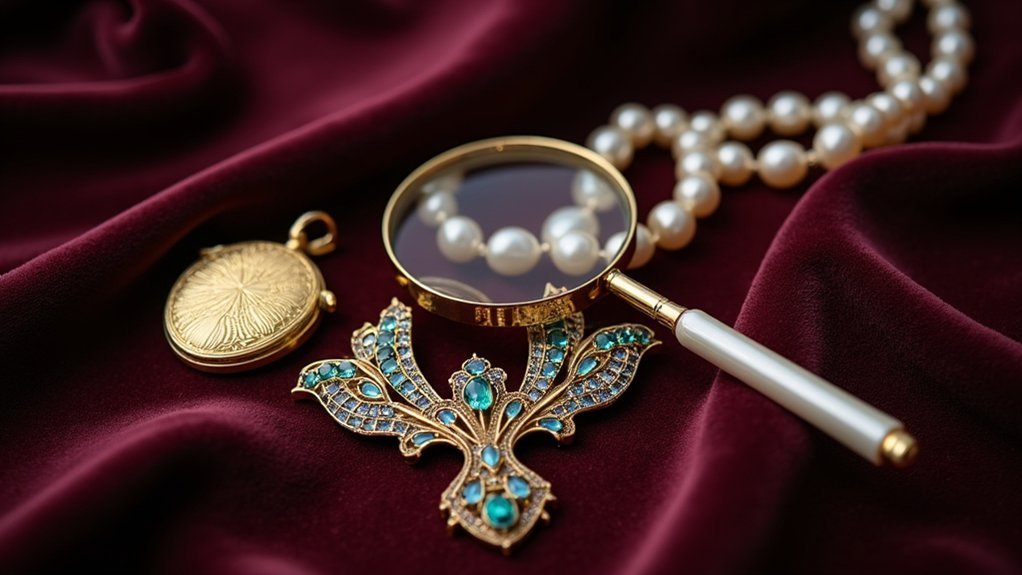
When you’re evaluating vintage jewelry, you’ll need to focus on several key factors that directly impact its market worth.
Start by examining the materials—precious metals and authentic gemstones greatly influence your piece’s value. Look for maker’s marks or designer stamps, as recognized brands command higher prices due to their established reputation and superior craftsmanship.
The condition of your antique jewelry is absolutely essential. Intact pieces with original components hold considerably more value than those that’ve been repaired or altered.
You’ll also want to research current market trends for specific periods like Art Deco or Mid-Century, since demand fluctuates regularly.
Finally, document your piece’s provenance thoroughly. A well-established history enhances authenticity and can significantly increase market value.
Researching Your Jewelry’s Historical Background and Provenance
Effective jewelry assessment extends beyond examining physical characteristics—you must uncover the story behind your piece to maximize its potential value.
Beyond gems and metals lies the true treasure—every piece of jewelry holds secrets that unlock its maximum value potential.
When you research the item’s historical significance, you’ll identify its era, design style, and cultural influences that shaped its creation. This knowledge directly impacts valuation.
Provenance documentation proves authenticity and ownership history. If your piece belonged to notable figures or carries intriguing stories, its value increases substantially.
Look for maker’s marks, stamps, or signatures that trace the jewelry’s origin and designer—renowned manufacturers command higher prices.
Research comparable auction results to establish realistic market values.
Utilize online databases, specialized appraisal services, and antique dealers to uncover your piece’s historical significance and current market trends for accurate assessment.
Identifying Maker’s Marks, Hallmarks, and Designer Signatures

Although tiny stamps and engravings might seem insignificant, these maker’s marks, hallmarks, and designer signatures hold the key to revealing your vintage piece’s true identity and value.
You’ll need magnification or special lighting to spot these often-small markings, which may be stamped or engraved on inconspicuous areas.
Once you’ve located the marks, research them thoroughly. These identifiers reveal essential information about the manufacturer, production dates, and rarity.
Items bearing recognizable designer signatures or official hallmarks typically command premium prices due to their association with reputable artisans.
Don’t just identify the mark—understand its historical context. Manufacturers often changed their marking systems over time, and knowing these variations helps you date your piece accurately and maximize its market appeal.
Evaluating Metal Types and Precious Metal Content
You’ll need to identify precious metal marks like karat stamps on gold or sterling marks on silver to determine your vintage piece’s true composition.
Testing metal authenticity through acid tests or electronic testers helps confirm whether you’re dealing with genuine precious metals or plated items.
Evaluating the purity levels accurately lets you calculate the actual precious metal content and establish a baseline value for your vintage piece.
Identifying Precious Metal Marks
Understanding precious metal marks serves as your gateway to accurately evaluating a vintage piece’s true value and authenticity.
When examining precious metals, you’ll find identifying marks that reveal essential information about composition and worth. Look for karat numbers like 10K, 14K, or 18K on gold items, or purity percentages such as 925 stamped on sterling silver pieces.
Silver items marked “sterling” or “925” contain at least 92.5% pure silver, meeting quality standards. Platinum pieces typically display “PT” or “plat” marks, indicating 95% pure platinum content, while white gold shows gold content combined with “white” or “WG” markings.
Research manufacturer hallmarks and brand stamps for additional verification. These unique identifiers help confirm authenticity and can greatly impact your vintage piece’s market value.
Testing Metal Authenticity
Several reliable methods can help you verify metal authenticity once you’ve identified the marks on your vintage piece.
Testing for precious metal content requires systematic approaches that’ll give you confidence in your evaluation.
Here are four proven testing methods:
- Magnet test – Non-ferrous metals like gold, silver, and platinum won’t be attracted to magnets, while ferrous metals will respond.
- Acid test – Make a small scratch and apply acid drops to determine purity based on the reaction.
- Specific gravity test – Calculate density by weighing the metal in air versus water.
- XRF analysis – Advanced non-destructive testing for precise composition analysis.
Hallmarks or stamps provide initial guidance, but these testing methods confirm authenticity.
When in doubt, consult a qualified appraiser for professional verification of valuable pieces.
Assessing Metal Purity Levels
Three distinct systems determine how metal purity gets measured across different precious metals. For gold, you’ll encounter the karat system where 24K represents pure gold, while 18K contains 75% gold and 14K holds 58.3%. Silver and platinum use parts per thousand, with sterling silver marking 925 (92.5% silver).
Understanding metal purity levels directly impacts accurate valuation of your valuable collectibles. You can verify purity through acid testing, electronic testing, or X-ray fluorescence methods. Always examine hallmarks and stamps for authenticity indicators.
| Metal Type | Purity Measurement | Common Grade | Percentage |
|---|---|---|---|
| Gold | Karats | 18K | 75% |
| Gold | Karats | 14K | 58.3% |
| Silver | Parts per thousand | Sterling 925 | 92.5% |
| Platinum | Parts per thousand | 950 | 95% |
Assessing Gemstone Quality, Authenticity, and Market Value
When evaluating vintage gemstones, you’ll need to verify their authenticity by examining their origins and obtaining certifications from reputable laboratories like GIA or AGS.
You should research current market pricing by analyzing recent sales data and auction results for comparable stones, as gemstone values fluctuate based on demand and rarity.
Don’t overlook how the Four Cs—carat weight, cut, color, and clarity—directly impact your stone’s market value, especially since inclusions can greatly reduce worth.
Authenticating Gemstone Origins
Before you can accurately assess a vintage piece’s worth, you’ll need to authenticate its gemstones through proper certification from reputable gemological laboratories like GIA, AGL, or Gübelin.
These detailed reports verify authenticity and origin, directly impacting the value of the item you’re evaluating.
Geographical origin greatly affects fair market value.
Consider these authentication steps:
- Request laboratory certification documenting the stone’s natural origin and characteristics
- Examine unique inclusions under magnification that distinguish natural from synthetic stones
- Verify provenance documentation linking stones to renowned sources like Kashmir or Colombia
- Consult an experienced antique dealer who can identify origin markers and historical context
Understanding these authentication factors helps establish fair market value, as stones from prestigious locations command premium prices in today’s collector market.
Current Market Pricing
Once you’ve confirmed authenticity through proper certification, you’ll need to evaluate current market pricing by systematically appraising the Four Cs—Carat weight, Cut, Color, and Clarity—which form the foundation of any gemstone’s value.
Research recent auction results and sales data for comparable vintage items to establish reliable benchmarks. Market conditions fluctuate considerably based on demand trends and economic factors, so you’ll want to monitor current pricing regularly.
Compare your piece against similar stones sold within the past six months through reputable auction houses. Don’t overlook how provenance affects the value of an item—documented history can substantially increase worth.
Professional appraisers familiar with vintage pieces provide expert insights into current market pricing that reflect today’s collector preferences and investment patterns.
Determining the Impact of Condition on Overall Worth
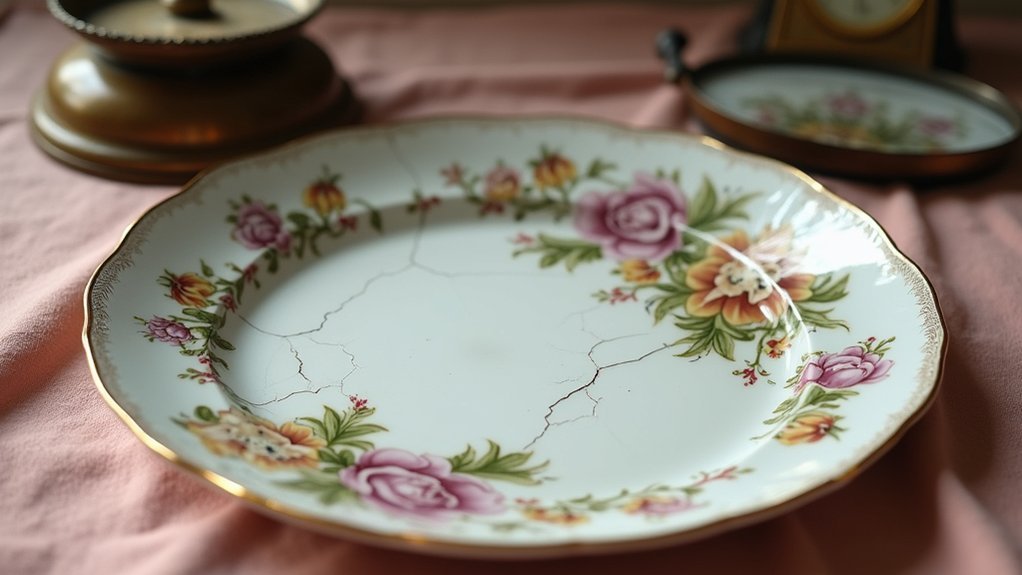
Though vintage pieces may capture your heart with their charm and history, their condition ultimately determines how much they’ll be worth in today’s market. Items in pristine, original condition command premium prices—often 20-50% higher than pieces showing wear.
Even seemingly minor flaws dramatically impact worth.
Here’s how condition affects your vintage piece’s value:
- Scratch and stain penalties – Visible defects can slash value by 30-40%
- Restoration risks – Repairs or repainting typically reduce worth since collectors prefer original condition
- Provenance advantages – Historical significance can offset some condition issues
- Professional assessment benefits – Regular appraisals help you understand true condition impact
You’ll maximize your piece’s worth by maintaining its original condition and seeking expert evaluations to accurately assess any damage effects.
Recognizing Different Jewelry Periods and Style Movements
You’ll markedly improve your valuation accuracy by learning to identify the distinct historical eras and style movements that shaped vintage jewelry design.
Each period carries unique characteristics in materials, motifs, and craftsmanship techniques that directly impact a piece’s authenticity and market value.
Mastering these visual markers helps you distinguish between a genuine Art Deco bracelet and a modern reproduction, ensuring you don’t overpay or undervalue potential treasures.
Historical Era Identification
When you’re examining vintage jewelry, recognizing the historical era becomes your first and most vital step in accurate valuation.
Historical era identification helps distinguish between antique and vintage pieces while determining their market worth. Each period showcases distinct characteristics that’ll guide your assessment of different types of jewelry.
Key identifying features include:
- Design motifs – Georgian intricate patterns versus Art Deco geometric shapes
- Material preferences – Victorian gold and diamonds versus Art Nouveau enamel work
- Construction techniques – Hand-forged Georgian pieces versus machine-made Retro jewelry
- Cultural influences – Victorian sentiment versus post-war Retro optimism
You’ll notice how each era reflects its time’s social values and technological advances, making accurate identification essential for proper valuation.
Style Movement Characteristics
Mastering style movement characteristics transforms you from a casual observer into a knowledgeable appraiser who can distinguish between periods and assign proper values. When evaluating vintage pieces, you’ll need to recognize distinct features that define each era. Victorian jewelry displays intricate floral motifs with precious metals, while Art Nouveau embraces organic flowing lines with enamel work. Arts and Crafts pieces emphasize handcrafted simplicity using semi-precious stones.
| Movement | Key Features | Materials |
|---|---|---|
| Art Deco | Geometric shapes, bold colors | Platinum, diamonds |
| Retro | Large gemstones, Hollywood glamour | Gold settings |
| Victorian | Intricate designs, nature motifs | Gold, silver, gemstones |
Understanding these characteristics helps you identify authentic types of items when shopping antique online, ensuring accurate valuations for your collection.
Utilizing Online Resources and Auction Database Research
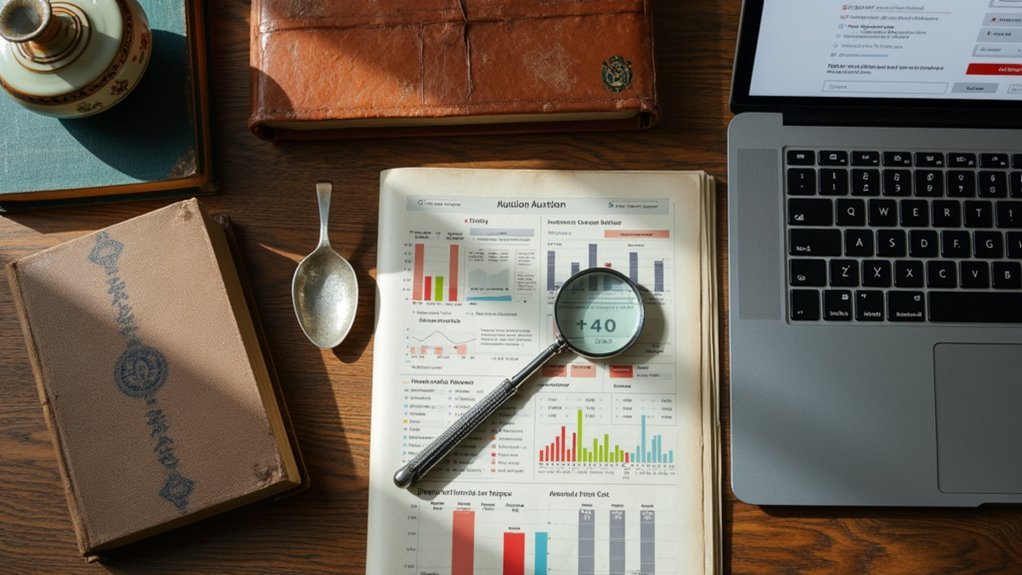
While traditional appraisal methods remain valuable, leveraging online resources and auction databases can dramatically accelerate your vintage piece research and provide real-time market data that’s often more current than printed guides.
Start by examining completed sales on eBay, filtering for “sold items” to see actual transaction prices rather than wishful listing amounts. This reveals what buyers actually paid for similar pieces, giving you concrete data about the value of your antique.
Here’s your research toolkit:
- Use reverse image searches through Google Lens to identify unknown items instantly.
- Join specialized antique forums on social media for expert insights and trend discussions.
- Browse dedicated platforms like Ruby Lane for targeted vintage market analysis.
- Track auction house results on Heritage Auctions to monitor long-term value trends.
These digital tools complement traditional expertise.
Consulting With Professional Jewelry Appraisers and Experts
Although online resources provide valuable preliminary insights, bringing your vintage jewelry to a certified professional appraiser guarantees you’ll receive the most accurate and thorough valuation possible. These experts use advanced gemological equipment like microscopes and refractometers to examine each item meticulously. They’ll help you accurately determine your piece’s historical significance, rarity, and market value based on current trends.
| Service | Benefit | Equipment Used |
|---|---|---|
| Authentication | Verifies genuine vintage pieces | Microscopes, UV lights |
| Market Analysis | Current pricing trends | Database access, comparison tools |
| Historical Research | Identifies makers’ marks | Reference materials, magnification |
| Condition Assessment | Documents wear and damage | Photography, measurement tools |
Professional appraisers guarantee your vintage jewelry that’s worth a lot receives proper documentation for insurance or resale purposes.
Understanding Different Types of Jewelry Valuations
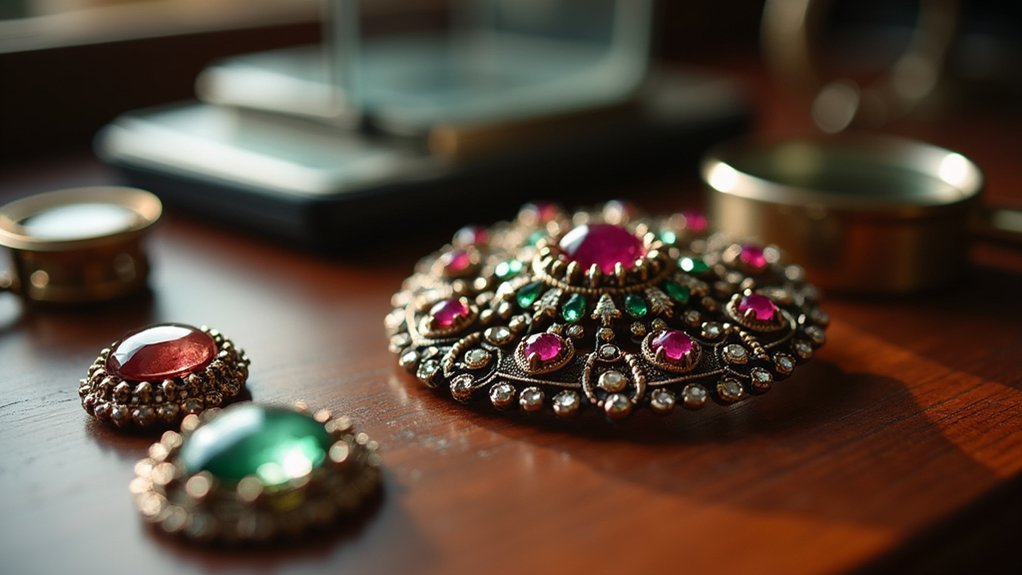
When you’re appraising vintage jewelry, you’ll encounter different valuation types that serve distinct purposes.
Insurance valuations typically reflect replacement value and run higher than market appraisals, which estimate what you’d actually receive if selling the piece.
Estate appraisals require specific documentation and methodology to meet legal requirements for inheritance, tax purposes, or probate proceedings.
Insurance Vs Market Value
Understanding the difference between insurance and market value becomes essential as you navigate vintage jewelry appraisals.
Insurance value reflects replacement costs, ensuring you can acquire a similar piece if loss occurs, while market value represents what buyers actually pay in today’s marketplace.
When obtaining appraisals, you’ll discover these key distinctions:
- Assessment factors – Insurance appraisers examine gemstone quality and craftsmanship, while market evaluators analyze recent comparable sales.
- Pricing levels – Insurance valuations typically exceed market prices by accounting for retail replacement costs.
- Price sources – Insurance reflects retail pricing, market value considers wholesale or auction results.
- Update frequency – Insurance appraisals need regular updates to maintain adequate coverage.
You’ll want separate appraisals for each purpose since these values can differ greatly for vintage pieces.
Estate Appraisal Requirements
Estate appraisals serve a distinctly different purpose from insurance valuations, as they determine fair market value for legal distribution among beneficiaries rather than replacement costs. You’ll need a certified gemologist or appraiser to meet estate appraisal requirements and guarantee legal recognition. They’ll accurately determine the value by examining gemstone quality, metal purity, and craftsmanship while considering current market trends affecting what antiques are worth.
| Factor | Estate Impact | Documentation Required |
|---|---|---|
| Gemstone Quality | Market desirability assessment | Certified grading report |
| Metal Purity | Current precious metal rates | Hallmark verification |
| Craftsmanship | Artisan reputation influence | Maker identification |
| Historical Significance | Provenance enhancement | Authentication records |
| Market Trends | Current demand fluctuation | Comparable sales data |
Update your appraisals every 3-5 years for accurate estate planning.
Avoiding Common Restoration Mistakes That Decrease Value
While restoration might seem like a logical way to enhance your vintage piece’s appeal, it often backfires by destroying the very qualities that made the item valuable in the first place.
Most collectors and buyers prefer items in their original condition, viewing any alterations as detrimental to authenticity and historical significance.
Avoid these critical restoration mistakes that can devastate your item’s value:
- Removing original paint or finishes – These elements are irreplaceable markers of historical authenticity.
- Making unauthorized repairs to scratches or dents without expert consultation.
- Replacing original hardware or components with modern alternatives.
- Over-cleaning surfaces that removes natural patina and character.
Documenting Your Pieces With Proper Photography and Records
Once you’ve preserved your vintage piece’s original condition, creating detailed documentation becomes your next priority for establishing and maintaining its value. Proper photography requires multiple angles, close-ups of markings, and context shots using natural lighting without flash to avoid distortion. Documenting each piece systematically creates a valuable reference for future appraisals.
| Photography Element | Best Practice | Purpose |
|---|---|---|
| Lighting | Natural light only | Accurate color capture |
| Angles | Multiple viewpoints | Complete documentation |
| Details | Close-up markings | Authentication support |
| Context | Full item shots | Size/scale reference |
| Storage | Digital organization | Easy retrieval |
Your records should include purchase history, condition notes, defects, repairs, and any professional valuations. This thorough documentation streamlines future evaluations and helps track market trends over time.
Staying Updated on Current Market Trends and Demand
Thorough documentation sets the foundation for tracking your vintage items’ value, but market forces constantly shift what collectors want and what they’ll pay.
Market dynamics drive collector preferences and pricing, making static valuations obsolete without continuous market awareness and trend monitoring.
You’ll need to actively monitor current market trends to maintain accurate valuations of your antiques and collectibles.
Here’s how to stay informed about market demand:
- Monitor online auction sites like eBay to track real-time selling prices and identify demand patterns for your specific vintage categories.
- Join social media groups and forums where collectors discuss emerging interests and market shifts in antiques.
- Attend antique shows and fairs to observe buyer behavior and gauge firsthand interest in various collectible categories.
- Connect with local dealers and appraisers who understand how current market trends affect specific vintage item valuations.
This ongoing research guarantees your pieces remain competitively priced.
Preparing for Professional Appraisal Services
Although market research gives you valuable insights into your vintage pieces’ potential worth, professional appraisal services provide the definitive valuations you’ll need for insurance, estate planning, or major sales decisions.
The first step involves gathering thorough documentation about your items, including provenance, previous appraisals, and detailed condition assessments. Clean your pieces carefully but avoid repairs that might reduce value.
Research qualified appraisers specializing in your specific vintage categories, as expertise directly impacts valuation accuracy. Prepare documentation highlighting historical significance, manufacturer marks, and unique characteristics.
During the appraisal, engage actively with the professional to understand their valuation methodology and current market influences. This preparation will help you find the best price and guarantee accurate assessments for your valuable vintage collection.
Frequently Asked Questions
How Do You Find Out What Vintage Items Are Worth?
You’ll discover vintage item values by checking sold eBay listings, examining manufacturer marks, consulting local antique dealers, evaluating condition thoroughly, and monitoring market trends through auction sites and collector groups regularly.
How to Get Vintage Items Valued?
You’ll get vintage items valued by visiting local antique specialists for free appraisals, researching completed eBay sales for comparable pieces, and consulting online collector communities while avoiding repairs beforehand.
What Is the 100 Year Rule for Antiques?
You’ll find the 100 Year Rule classifies items as antiques when they’re at least 100 years old. It’s the industry standard that separates true antiques from vintage pieces and contemporary collectibles.
What Is the App That Scans Antiques for Value?
You can use WorthPoint or Valuables by Your Antique Dealer to scan antiques. These apps utilize AI image recognition to identify items and provide estimated values by comparing against databases of similar antiques and sales.
In Summary
You’ve now equipped yourself with the essential knowledge to accurately value your vintage jewelry collection. Don’t rush through the assessment process—take time to thoroughly research each piece’s history, examine maker’s marks, and evaluate materials carefully. You’ll protect your investment by avoiding hasty restorations and maintaining detailed documentation. Stay informed about market trends, and when you’re ready, seek professional appraisals to confirm your findings and guarantee accurate valuations.

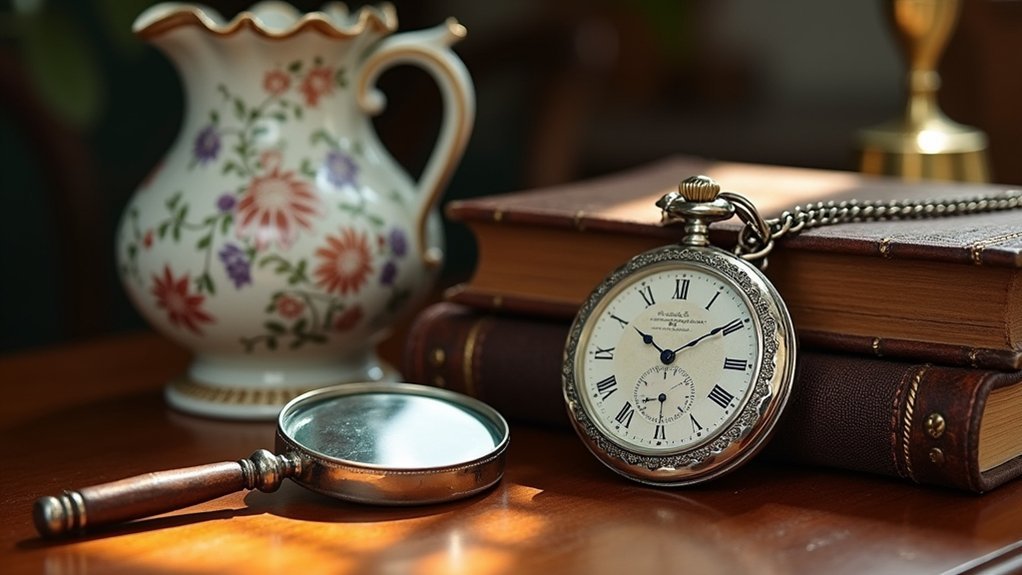



Leave a Reply